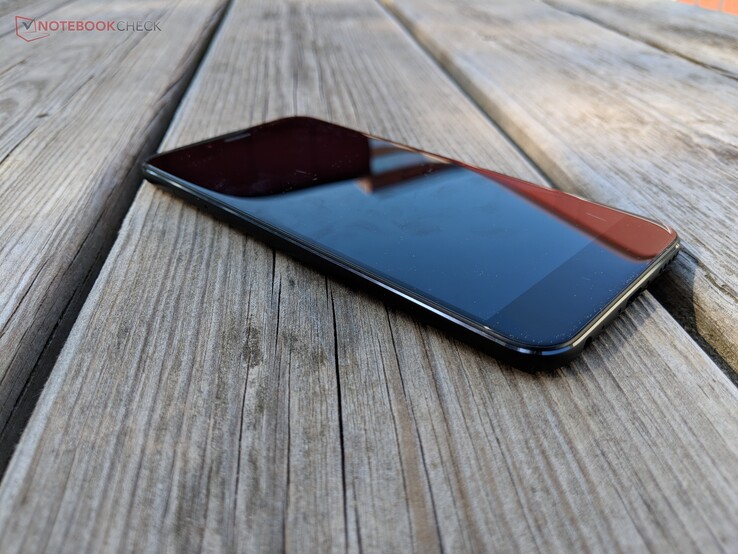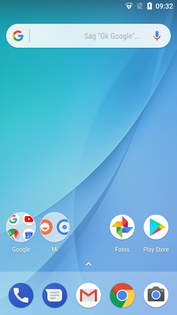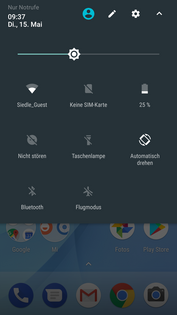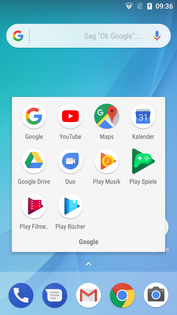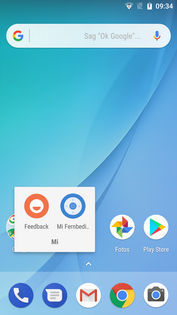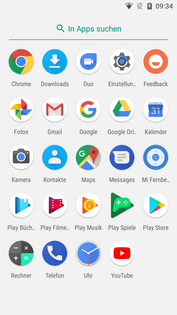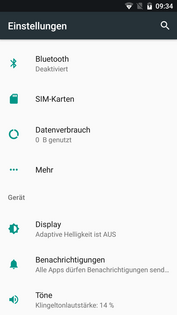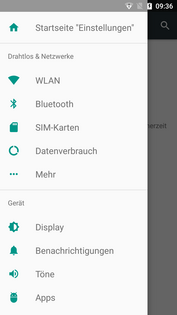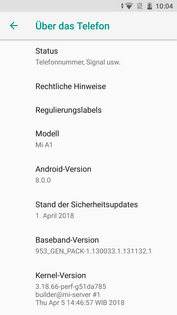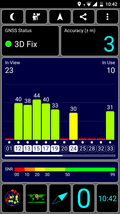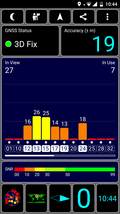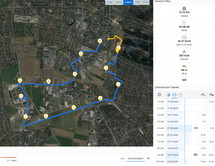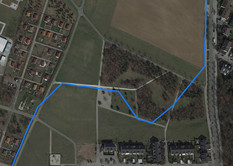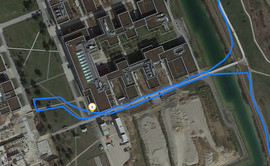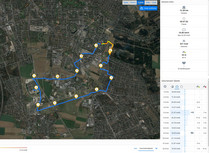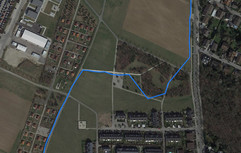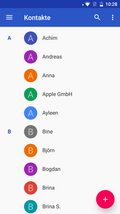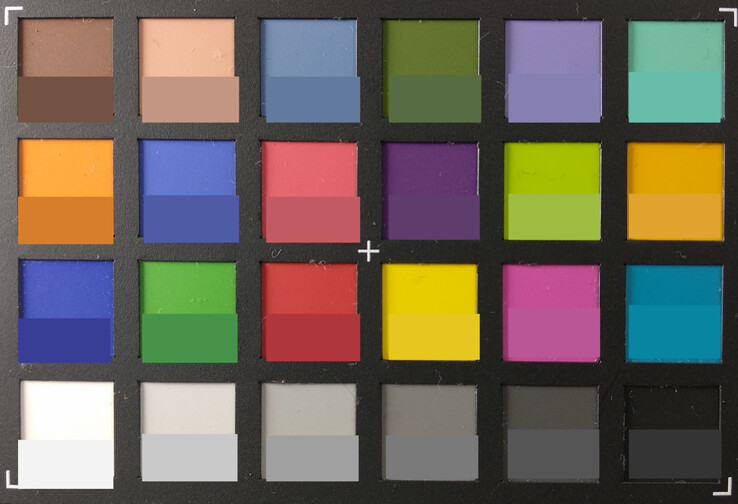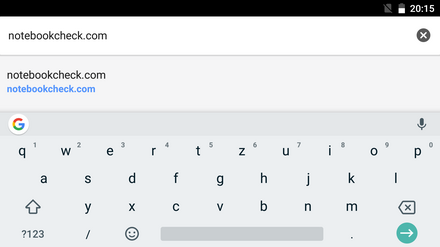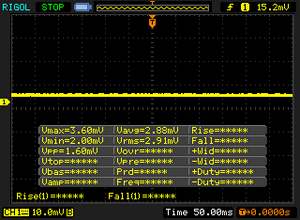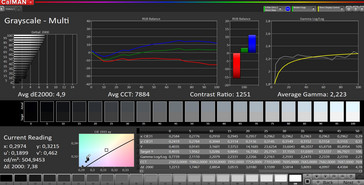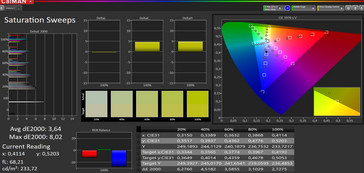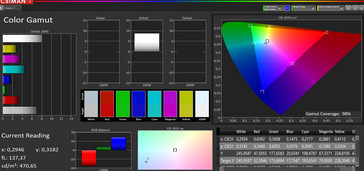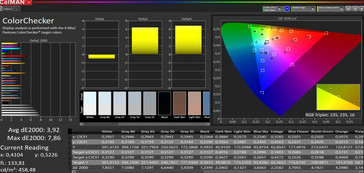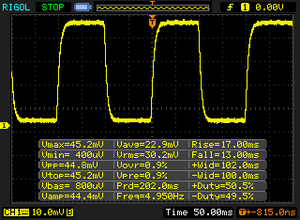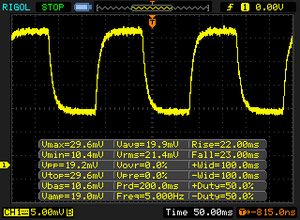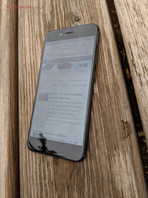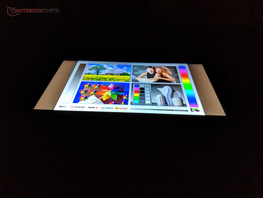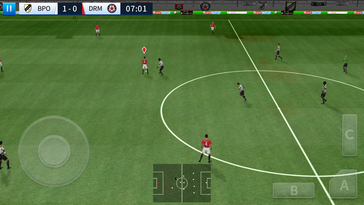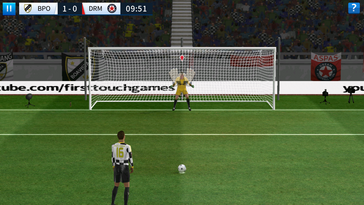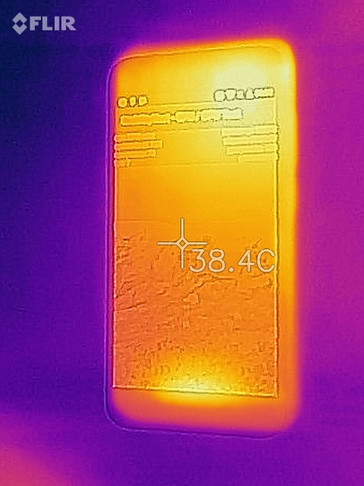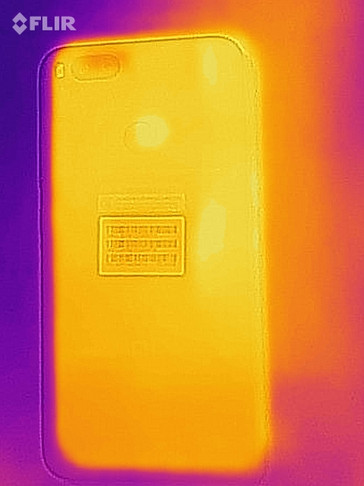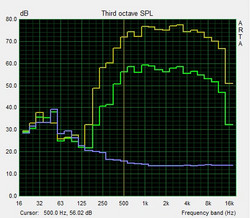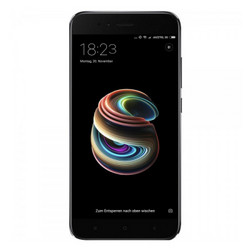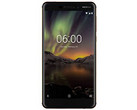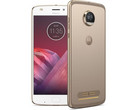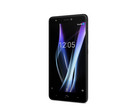Xiaomi Mi A1 Smartphone Review
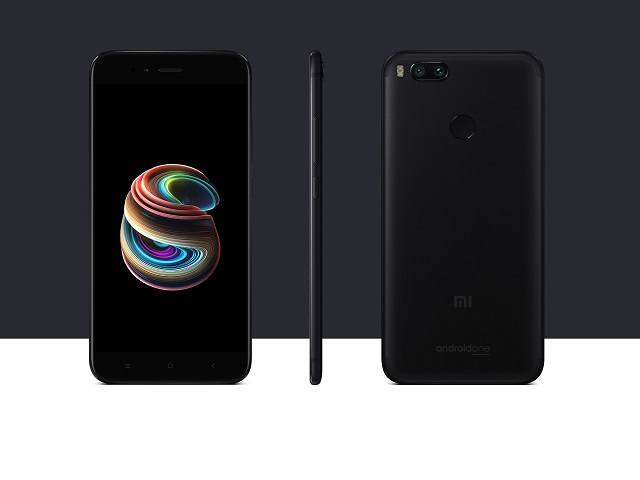
While the Mi A1 has identical hardware to the Mi 5X, the difference is that the Mi A1 additionally supports band 20 which is used in Germany. Furthermore, the Mi A1 is the first smartphone from Xiaomi that does not use the MIUI operating system which was developed in-house. Instead, the device has an Android-One certification, which means that the Chinese electronics manufacturer has installed a pure version of Android on the smartphone. This also results in a two-year update warranty and regular security updates.
The Xiaomi smartphone is equipped with a 5.5-inch display that has a Full HD resolution. The device is driven by a Snapdragon 625 and an Adreno 506 graphics processor. This hardware is supported by 64 GB of internal storage and 4 GB of working memory. The battery offers 3080 mAh. Visually, the Xiaomi Mi A1 reminds a little of an iPhone. The case has a height of 155.4 mm, width of 75.8 mm, and thickness of 7.3 mm (6.1 x 3 x 0.29 in) and the device weighs 165 grams (5.8 oz).
The competitors of the Mi A1 include the Nokia 6 (2018), the BQ Aquaris Pro, and the Motorola Z2 Play. All four smartphones are part of the mid-range performance segment and are equipped with pure Android or part of the Android One project, like the Mi A1 and the Nokia 6 (2018).
Case - A very well-built aluminum case
Visually, the Mi A1 reminds a little of an iPhone 6S, 7, or 8 Plus. As always, whether you like this design or not is of course purely a matter of taste. The device has a unibody aluminum case, which is excellently built. Nothing wobbles or creaks.
The smartphone feels good in the hands and also looks very high-quality thanks to its aluminum case. You can look in vain for large or uneven gaps in the Mi A1. The workmanship is absolutely high-quality, and in terms of its case, the Mi A1 can definitely keep up with the upper mid-range beyond 400 Euros (~$472).
On the right side are the volume keys and the power button. The workmanship is very good here as well, and the keys are set tightly into their places and have a comfortable pressure point. On the left side is the SIM-card tray, which can either accept two nano-SIM cards or one nano-SIM card and one microSD card. On the bottom are the audio port, the microphone, a USB-C connection, and the speaker. On the top are an additional microphone and an infrared transmitter, and on the back there is the dual-camera system and the fingerprint reader. Below the 5.5-inch display are three sensor keys and above the display there is the speaker, a front camera, and the brightness sensor.
Connections - All you need
In the Mi A1 as well as in the Mi 5X, Xiaomi uses the very popular Snapdragon 625 mid-range processor. The octa-core processor has a clock speed of up to 2.0 GHz and is accompanied by the Adreno 506 graphics unit, 4 GB of working memory, and 64 GB internal storage.
At the back of the smartphone is the fingerprint sensor. Even though it is not the fastest in this price range, it was able to cleanly unlock the device 10 times out of 10 during our test. The Mi A1 is one of the smartphones that comes with a 3.5 mm audio port without needing an adapter. The port is at the bottom of the device, together with the USB-C port which serves for charging and data transfer.
The smartphone can be officially ordered in the colors black, gold, and rose gold. While the Xiaomi website only lists a single version with 64 GB internal storage and 4 GB of working memory in the colors above, at this point you can also find a 32-GB version and even an additional color which reminds us of the Apple Red Edition in various online shops.
Software - More is less
The Mi A1 takes part in the Android One project, which Google started in 2014. The advantages of Android One are stock Android, regular security updates, and an update warranty of two years.
Accordingly, Xiaomi delivers the smartphone with a pure, unmodified Android. There are only two additional apps Xiaomi preinstalled. These are the Mi Feedback app and an app to control the infrared transmitter. Additionally, the Android camera app was replaced by the MIUI camera app.
While initially the Mi A1 comes with Android 7.1.1, at the beginning of the year the smartphone received the Oreo update. Security updates are always offered in a timely manner, so that you can still get the corresponding update in the same month.
Communications and GPS - Band 20 and stable WLAN
The Mi A1 supports all the frequencies/bands that are used in Germany, including band 20 which is particularly relevant in rural areas. It also supports LTE Cat. 6, which enables a maximum of 300 Mbit/s during download and 50 Mbit/s during upload. During our test, the mobile reception was surprisingly good in a rural area and we were even able to always use LTE outdoors.
The WLAN module of the Xiaomi Mi A1 operates in the 2.4 and 5.0-GHz bands and handles the IEEE-802.11 a/b/g/n/ac standards. The transfer rates to our Linksys EA8500 reference router are slightly above average. The download and upload rates during active use were always very good, no matter whether we were standing right in front of the router or in another room that was separated from the router by one or two walls.
| Networking | |
| iperf3 transmit AX12 | |
| Nokia 6 2018 | |
| Xiaomi Mi A1 | |
| BQ Aquaris X Pro | |
| Lenovo Moto Z2 Play | |
| iperf3 receive AX12 | |
| Nokia 6 2018 | |
| BQ Aquaris X Pro | |
| Xiaomi Mi A1 | |
| Lenovo Moto Z2 Play | |
The Xiaomi smartphone supports the GPS, A-GPS, Glonass, and BeiDou satellite networks. The mobile locating via GPS works fairly accurately and the operation of the built-in GPS sensor is always very reliable outdoors as well as indoors.
Our team tests the accuracy of the navigation of the Mi A1 using the Runtastic Pro app and compares this with the Garmin Edge 500 navigation system. While the Garmin Edge 500 measured a total route of 13.38 kilometers (8.31 miles), the measured route of the Mi A1 was 13.32 kilometers (8.28 miles). For such a long test route, this discrepancy is negligible, so the Xiaomi Mi A1 does very well overall for its price range in this test.
Telephone Functions and Call Quality - Very good with a small caveat
The Xiaomi Mi A1 uses the standard Google telephone app. In addition to menu items for Favorites, Recent (calls), and Contacts, there is also the button for the number key pad in order to dial a number.
The call quality of the Mi A1 is completely convincing. Our conversation partner does not sound tinny, nor does our voice arrive tinny at their end. There is hardly any difference whether you are inside a building or outdoors. While the voice quality when calling with a headset is good, the plugged-in headset did not always work 100%. At times the communication could not be established at all or was only one-sided. Even changing the headset did not alleviate the problem here, and the sporadic failures still happened.
Cameras - Convincing throughout
With the Mi A1, Xiaomi is following the current dual-camera trend as well. The first thing we should mention is that compared to many other Chinese smartphones, the desired Bokeh (depth blurring) effect works very well here and comes relatively close to current flagship models. Xiaomi uses a dual-camera system with 2 x 12 MP lenses and one aperture of f/2.2 and one of f/2.6.
For the front camera, Xiaomi uses a 5-MP camera with an f/2.0 aperture.
For a device that costs less than 200 Euros (~$236; around $198 in the US), the recorded images are better than average, and that is not only during daylight but also indoors and in worse light conditions. Only the video-recordings are unconvincing. Due to the lack of an image stabilizer, the videos are very blurry, and video-recordings will only succeed if you have a really steady hand.
We test the image sharpness and color reproduction of the Mi A1 again under standardized light conditions in our test lab. Taking a picture of the ColorChecker, the colors are mostly quite accurate and only deviate a little from the actual reference colors.
In order to evaluate the sharpness of the photos, we take a picture of our test chart under controlled artificial light. While the text and lines can be seen clearly, the edges of the image tend towards some slight blurriness.
Accessories and Warranty - Protective display cover included
Currently, it is still difficult to process a warranty claim directly with Xiaomi in European countries, since there are only a few Xiaomi shops there (and none in Germany). The warranty will therefore go through the vendor where you purchased the device, and the general warranty regulations in your country will be effective. Please see our Guarantees, Return policies and Warranties FAQ for country-specific information.
The accessories included with the Mi A1 can be quickly listed. Apart from the device, the box includes a USB-C data cable and the charger, a SIM-card tool, a quick-start description, and a screen protector with a cleaning cloth.
Input Devices and Operation - Standard keyboard and capacitive keys
The Mi A1 has three illuminated capacitive keys, which are below the display. They correspond to the Multitasking, Home, and Back functions. By default, the Standard Google GBoard keyboard is available for text and numeric input.
Display - Sunlight? Oh yes, I saw something...
Xiaomi has equipped the Mi A1 with a 5.5-inch LCD that has a resolution of 1920x1080 pixels, corresponding to a pixel density of 403 ppi. This display has a brightness sensor in the area at the top which works reliably and very well. During the whole test period, it did not even occur to us that we should manually readjust the brightness.
| |||||||||||||||||||||||||
Brightness Distribution: 88 %
Contrast: 1359:1 (Black: 0.37 cd/m²)
ΔE ColorChecker Calman: 3.92 | ∀{0.5-29.43 Ø4.78}
ΔE Greyscale Calman: 4.9 | ∀{0.09-98 Ø5}
98% sRGB (Calman 2D)
Gamma: 2.223
CCT: 7884 K
| Xiaomi Mi A1 IPS, 1920x1080, 5.5" | Nokia 6 2018 IPS, 1920x1080, 5.5" | BQ Aquaris X Pro IPS, 1920x1080, 5.2" | Lenovo Moto Z2 Play AMOLED, 1920x1080, 5.5" | |
|---|---|---|---|---|
| Screen | -36% | -45% | -7% | |
| Brightness middle (cd/m²) | 503 | 417 -17% | 458 -9% | 434 -14% |
| Brightness (cd/m²) | 478 | 421 -12% | 473 -1% | 404 -15% |
| Brightness Distribution (%) | 88 | 88 0% | 88 0% | 81 -8% |
| Black Level * (cd/m²) | 0.37 | 0.61 -65% | 0.51 -38% | |
| Contrast (:1) | 1359 | 684 -50% | 898 -34% | |
| Colorchecker dE 2000 * | 3.92 | 6.1 -56% | 7.1 -81% | 4.4 -12% |
| Colorchecker dE 2000 max. * | 7.86 | 11.2 -42% | 14.5 -84% | 8.6 -9% |
| Greyscale dE 2000 * | 4.9 | 7.1 -45% | 10.5 -114% | 4.2 14% |
| Gamma | 2.223 99% | 2.16 102% | 2.28 96% | 2.24 98% |
| CCT | 7884 82% | 8362 78% | 8951 73% | 7343 89% |
* ... smaller is better
Screen Flickering / PWM (Pulse-Width Modulation)
| Screen flickering / PWM not detected | |||
In comparison: 53 % of all tested devices do not use PWM to dim the display. If PWM was detected, an average of 8111 (minimum: 5 - maximum: 343500) Hz was measured. | |||
Directly when turning on the Mi A1, you already notice that the colors of the IPS panel appear very strong and natural. The black values are very good for an IPS display. The color reproduction deviates only slightly from the sRGB color space, but keep in mind that the color-space coverage is only an approximate value.
The display shows slight weaknesses in the gray values, tending towards showing a blue tint. The measured contrast is also acceptable for a device of this price range.
Display Response Times
| ↔ Response Time Black to White | ||
|---|---|---|
| 30 ms ... rise ↗ and fall ↘ combined | ↗ 17 ms rise | |
| ↘ 13 ms fall | ||
| The screen shows slow response rates in our tests and will be unsatisfactory for gamers. In comparison, all tested devices range from 0.1 (minimum) to 240 (maximum) ms. » 79 % of all devices are better. This means that the measured response time is worse than the average of all tested devices (20.2 ms). | ||
| ↔ Response Time 50% Grey to 80% Grey | ||
| 55 ms ... rise ↗ and fall ↘ combined | ↗ 22 ms rise | |
| ↘ 23 ms fall | ||
| The screen shows slow response rates in our tests and will be unsatisfactory for gamers. In comparison, all tested devices range from 0.165 (minimum) to 636 (maximum) ms. » 91 % of all devices are better. This means that the measured response time is worse than the average of all tested devices (31.6 ms). | ||
The display built into the Mi A1 is based on IPS technology. With this, the Xiaomi smartphone has very good viewing-angle stability and there are no color distortions or blue veils, as can occur in OLED displays. Even at steep viewing angles, there are no color distortions; the screen merely appears a little darker. Outdoors or in bright surroundings, the display is always sufficiently readable.
Performance - Mid-range but sufficient
Xiaomi has equipped the Mi A1 with the very popular Snapdragon 625 mid-range processor and 4 GB of working memory. The Snapdragon 625 offers a good performance while being extremely energy-efficient. The octa-core processor has a maximum clock speed of 2.0 GHz and is excellently suited for standard tasks such as emails, surfing on the web or social networks, and playing videos and standard games. However, if it is important to you to play more-demanding 3D games, you should choose a more powerful device. For example, Xiaomi has introduced the Black Shark gamer smartphone.
| AnTuTu v6 - Total Score (sort by value) | |
| Xiaomi Mi A1 | |
| Nokia 6 2018 | |
| BQ Aquaris X Pro | |
| Lenovo Moto Z2 Play | |
| Average Qualcomm Snapdragon 625 (59867 - 68348, n=17) | |
| PCMark for Android | |
| Work performance score (sort by value) | |
| Xiaomi Mi A1 | |
| Nokia 6 2018 | |
| BQ Aquaris X Pro | |
| Lenovo Moto Z2 Play | |
| Average Qualcomm Snapdragon 625 (4596 - 7846, n=16) | |
| Work 2.0 performance score (sort by value) | |
| Xiaomi Mi A1 | |
| Nokia 6 2018 | |
| BQ Aquaris X Pro | |
| Lenovo Moto Z2 Play | |
| Average Qualcomm Snapdragon 625 (4626 - 5558, n=14) | |
| GFXBench 3.0 | |
| on screen Manhattan Onscreen OGL (sort by value) | |
| Xiaomi Mi A1 | |
| Nokia 6 2018 | |
| BQ Aquaris X Pro | |
| Lenovo Moto Z2 Play | |
| Average Qualcomm Snapdragon 625 (7.4 - 19, n=17) | |
| Average of class Smartphone (18 - 166, n=159, last 2 years) | |
| 1920x1080 1080p Manhattan Offscreen (sort by value) | |
| Xiaomi Mi A1 | |
| Nokia 6 2018 | |
| BQ Aquaris X Pro | |
| Lenovo Moto Z2 Play | |
| Average Qualcomm Snapdragon 625 (3.1 - 10, n=17) | |
| Average of class Smartphone (12 - 606, n=158, last 2 years) | |
| GFXBench 3.1 | |
| on screen Manhattan ES 3.1 Onscreen (sort by value) | |
| Xiaomi Mi A1 | |
| Nokia 6 2018 | |
| BQ Aquaris X Pro | |
| Lenovo Moto Z2 Play | |
| Average Qualcomm Snapdragon 625 (3.1 - 14, n=17) | |
| Average of class Smartphone (11 - 166, n=159, last 2 years) | |
| 1920x1080 Manhattan ES 3.1 Offscreen (sort by value) | |
| Xiaomi Mi A1 | |
| Nokia 6 2018 | |
| BQ Aquaris X Pro | |
| Lenovo Moto Z2 Play | |
| Average Qualcomm Snapdragon 625 (3.5 - 14, n=17) | |
| Average of class Smartphone (8.4 - 413, n=158, last 2 years) | |
| JetStream 1.1 - Total Score | |
| Lenovo Moto Z2 Play (Chrome 59) | |
| Nokia 6 2018 (Browser: Chrome 65) | |
| Average Qualcomm Snapdragon 625 (21.3 - 31.8, n=17) | |
| BQ Aquaris X Pro (Chrome 59.0.3071.125) | |
| Xiaomi Mi A1 | |
| Octane V2 - Total Score | |
| Average of class Smartphone (2228 - 121337, n=201, last 2 years) | |
| Lenovo Moto Z2 Play (Chrome 59) | |
| Nokia 6 2018 (Browser: Chrome 65) | |
| Xiaomi Mi A1 | |
| Average Qualcomm Snapdragon 625 (3781 - 4979, n=17) | |
| BQ Aquaris X Pro (Chrome 59.0.3071.125) | |
| Mozilla Kraken 1.1 - Total | |
| Nokia 6 2018 (Browser: Chrome 65) | |
| Xiaomi Mi A1 | |
| Average Qualcomm Snapdragon 625 (8028 - 12194, n=17) | |
| BQ Aquaris X Pro (Chrome 59.0.3071.125) | |
| Lenovo Moto Z2 Play (Chrome 59) | |
| Average of class Smartphone (257 - 28190, n=156, last 2 years) | |
* ... smaller is better
The internal storage of the Mi A1 is 64 GB in our test unit and you can also purchase a device with 32 GB of internal storage. This can be expanded via microSD, microSDHC, or microSDXC card if necessary. Once the microSD card is recognized by the device, you can choose between the options to use as portable storage or internal storage.
| Xiaomi Mi A1 | Nokia 6 2018 | BQ Aquaris X Pro | Lenovo Moto Z2 Play | Average 64 GB eMMC Flash | Average of class Smartphone | |
|---|---|---|---|---|---|---|
| AndroBench 3-5 | 4% | -6% | 78% | 55% | 1582% | |
| Sequential Read 256KB (MB/s) | 277.4 | 272.6 -2% | 270.5 -2% | 245.6 -11% | 277 ? 0% | 2216 ? 699% |
| Sequential Write 256KB (MB/s) | 202.4 | 118.3 -42% | 139.6 -31% | 137.5 -32% | 178.4 ? -12% | 1837 ? 808% |
| Random Read 4KB (MB/s) | 78.1 | 38.78 -50% | 37.97 -51% | 38.2 -51% | 60.7 ? -22% | 294 ? 276% |
| Random Write 4KB (MB/s) | 7.19 | 15.3 113% | 12.07 68% | 47.9 566% | 33.8 ? 370% | 334 ? 4545% |
| Sequential Read 256KB SDCard (MB/s) | 83.6 | 83.4 ? 0% | 78.7 ? -6% | 79.7 ? -5% | 77.4 ? -7% | |
| Sequential Write 256KB SDCard (MB/s) | 57.9 | 61.3 ? 6% | 49.77 ? -14% | 58.7 ? 1% | 58.3 ? 1% |
Games - Not a gaming machine but acceptable
The Snapdragon 625 is accompanied by the Adreno 506 GPU which has a clock speed of 650 MHz. According to the manufacturer Qualcomm, the Adreno 506 GPU is supposed to be software compatible with the Adreno 530 top model in the Snapdragon 820.
Games such as Dream League Soccer 2018 and Shadow Fight 3 run smoothly and can be controlled well by the touchscreen.
Emissions - No warming worth mention
Temperature
In everyday usage, the temperature development of the Mi A1 poses no problem. Even during longer gaming or surfing, the smartphone does not feel particularly warm. Under full load of the systems (CPU and GPU) in the stress test using the application stability test for at least one hour, the smartphone warms up to a maximum of 37.6 °C (100 °F) at the front of the device and 36.6 °C (98 °F) at the back.
(+) The maximum temperature on the upper side is 37.6 °C / 100 F, compared to the average of 35.2 °C / 95 F, ranging from 21.9 to 247 °C for the class Smartphone.
(+) The bottom heats up to a maximum of 36.6 °C / 98 F, compared to the average of 34 °C / 93 F
(+) In idle usage, the average temperature for the upper side is 29 °C / 84 F, compared to the device average of 32.9 °C / 91 F.
Speaker
Xiaomi has positioned the speaker of the Mi A1 on the bottom of the case. With its 86.2 dB(A) at full volume, the smartphone does well, and even at this volume the Mi A1 convinces with a clear sound. There were no distortions or uncomfortable noises. However, like almost all smartphones, the Xiaomi also has difficulties reproducing songs that are bass-heavy, and the bass is almost completely drowned out.
Headphones can be connected to the device via the 3.5 mm audio jack. The sound quality via the headphone output is very good, and in this way it is pleasant to listen to bass-heavy songs with the corresponding output device.
Xiaomi Mi A1 audio analysis
(+) | speakers can play relatively loud (86.2 dB)
Bass 100 - 315 Hz
(-) | nearly no bass - on average 29.7% lower than median
(±) | linearity of bass is average (11.2% delta to prev. frequency)
Mids 400 - 2000 Hz
(+) | balanced mids - only 3.2% away from median
(+) | mids are linear (5.2% delta to prev. frequency)
Highs 2 - 16 kHz
(+) | balanced highs - only 3.2% away from median
(+) | highs are linear (3.1% delta to prev. frequency)
Overall 100 - 16.000 Hz
(±) | linearity of overall sound is average (19.2% difference to median)
Compared to same class
» 25% of all tested devices in this class were better, 8% similar, 66% worse
» The best had a delta of 11%, average was 35%, worst was 134%
Compared to all devices tested
» 45% of all tested devices were better, 7% similar, 47% worse
» The best had a delta of 4%, average was 24%, worst was 134%
Nokia 6 2018 audio analysis
(+) | speakers can play relatively loud (87.2 dB)
Bass 100 - 315 Hz
(-) | nearly no bass - on average 29.6% lower than median
(±) | linearity of bass is average (7.2% delta to prev. frequency)
Mids 400 - 2000 Hz
(+) | balanced mids - only 4.4% away from median
(±) | linearity of mids is average (7% delta to prev. frequency)
Highs 2 - 16 kHz
(±) | higher highs - on average 6.9% higher than median
(+) | highs are linear (3.2% delta to prev. frequency)
Overall 100 - 16.000 Hz
(±) | linearity of overall sound is average (23.2% difference to median)
Compared to same class
» 52% of all tested devices in this class were better, 7% similar, 41% worse
» The best had a delta of 11%, average was 35%, worst was 134%
Compared to all devices tested
» 69% of all tested devices were better, 5% similar, 26% worse
» The best had a delta of 4%, average was 24%, worst was 134%
BQ Aquaris X Pro audio analysis
(+) | speakers can play relatively loud (86.1 dB)
Bass 100 - 315 Hz
(-) | nearly no bass - on average 26.4% lower than median
(±) | linearity of bass is average (10% delta to prev. frequency)
Mids 400 - 2000 Hz
(+) | balanced mids - only 4.5% away from median
(+) | mids are linear (5.9% delta to prev. frequency)
Highs 2 - 16 kHz
(±) | higher highs - on average 11.1% higher than median
(+) | highs are linear (6.7% delta to prev. frequency)
Overall 100 - 16.000 Hz
(±) | linearity of overall sound is average (26% difference to median)
Compared to same class
» 65% of all tested devices in this class were better, 6% similar, 28% worse
» The best had a delta of 11%, average was 35%, worst was 134%
Compared to all devices tested
» 79% of all tested devices were better, 4% similar, 16% worse
» The best had a delta of 4%, average was 24%, worst was 134%
Lenovo Moto Z2 Play audio analysis
(+) | speakers can play relatively loud (86.8 dB)
Bass 100 - 315 Hz
(-) | nearly no bass - on average 30.9% lower than median
(±) | linearity of bass is average (9.6% delta to prev. frequency)
Mids 400 - 2000 Hz
(+) | balanced mids - only 4.9% away from median
(+) | mids are linear (5.3% delta to prev. frequency)
Highs 2 - 16 kHz
(+) | balanced highs - only 1.9% away from median
(+) | highs are linear (3.6% delta to prev. frequency)
Overall 100 - 16.000 Hz
(±) | linearity of overall sound is average (19.3% difference to median)
Compared to same class
» 26% of all tested devices in this class were better, 9% similar, 65% worse
» The best had a delta of 11%, average was 35%, worst was 134%
Compared to all devices tested
» 46% of all tested devices were better, 8% similar, 47% worse
» The best had a delta of 4%, average was 24%, worst was 134%
Battery life - High power usage
Power Consumption
In terms of the battery, the Xiaomi Mi A1 is anything but an energy-efficient device. In our test, the Mi A1 always had higher power consumption than the comparison devices. In tasks that demand the maximum performance of the smartphone, the consumption can quickly rise to 7.2 watts.
| Off / Standby | |
| Idle | |
| Load |
|
Key:
min: | |
| Xiaomi Mi A1 3080 mAh | Nokia 6 2018 3000 mAh | BQ Aquaris X Pro 3100 mAh | Lenovo Moto Z2 Play 3000 mAh | Average Qualcomm Snapdragon 625 | Average of class Smartphone | |
|---|---|---|---|---|---|---|
| Power Consumption | 49% | 40% | 69% | 37% | 18% | |
| Idle Minimum * (Watt) | 2.2 | 0.67 70% | 0.67 70% | 0.45 80% | 0.981 ? 55% | 0.848 ? 61% |
| Idle Average * (Watt) | 2.8 | 1.76 37% | 1.7 39% | 0.78 72% | 1.985 ? 29% | 1.434 ? 49% |
| Idle Maximum * (Watt) | 3.4 | 1.78 48% | 1.78 48% | 0.84 75% | 2.27 ? 33% | 1.618 ? 52% |
| Load Average * (Watt) | 6.2 | 2.82 55% | 4.42 29% | 1.69 73% | 3.51 ? 43% | 7.01 ? -13% |
| Load Maximum * (Watt) | 7.2 | 4.56 37% | 6.3 12% | 3.79 47% | 5.38 ? 25% | 11.3 ? -57% |
* ... smaller is better
Battery Life
The Mi A1 is equipped with a 3080 mAh battery. In our WLAN test, the device lasted for 10:33 hours. For anyone who uses their smartphone very little and only occasionally checks their email during the day, surfs through the social networks, or checks news on the web, the battery might generally last about two days. But for those who are not that disciplined when it comes to surfing, it means that the smartphone needs to be charged almost daily. It takes about 1:45 hours to fully recharge the battery with the included charger.
| Xiaomi Mi A1 3080 mAh | Nokia 6 2018 3000 mAh | BQ Aquaris X Pro 3100 mAh | Lenovo Moto Z2 Play 3000 mAh | |
|---|---|---|---|---|
| Battery runtime | 48% | 15% | 18% | |
| WiFi v1.3 (h) | 10.6 | 15.7 48% | 12.2 15% | 12.5 18% |
| Reader / Idle (h) | 30.6 | 30.7 | 26.5 | |
| H.264 (h) | 11.3 | 10.7 | 15.8 | |
| Load (h) | 6 | 4.2 | 8 |
Pros
Cons
Verdict - Quite worth consideration
The Mi A1 is the first smartphone from Xiaomi that is not delivered with the in-house MIUI operating system; it comes with stock Android instead. Since the Mi A1 is part of the Android One project, you are ensured of quick security updates and an update warranty of two years. As the smartphone was developed in a manner targeted for the European market, the often necessary LTE band 20 is also on board. In terms of its hardware, the Xiaomi Mi A1 is a very good mid-range smartphone.
One of the advantages of the Xiaomi smartphones is its camera, which for its price-range takes excellent pictures with the Bokeh (depth blurring) effect. In addition, the device offers a sharp and bright display, a processor and working memory that are sufficiently sized for standard applications, USB-C, and a fingerprint reader that works very reliably even though it is not the fastest on the market. Anyone using the Mi A1 for navigation can also be sure of having made a good choice.
Alternative devices to the Xiaomi Mi A1 are, for example, the Nokia 6 (2018), the BQ Aquaris x Pro, and the Motorola Z2 Play. All these devices come with stock Android and offer similar performance. In terms of its price, the Mi A1 currently lies even significantly below the alternative devices.
Xiaomi Mi A1
- 06/14/2018 v6 (old)
Christian Irion




